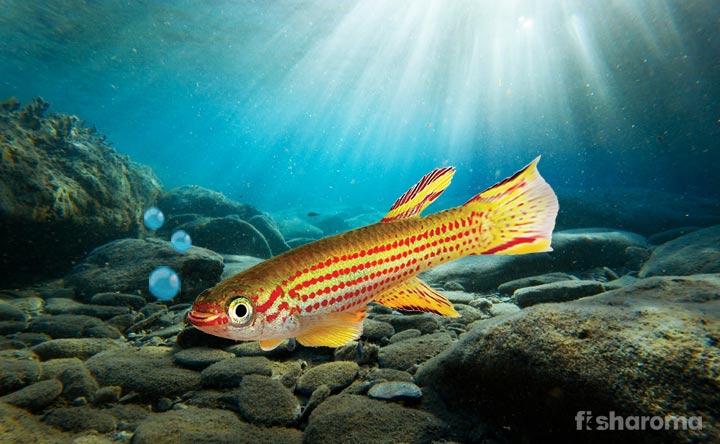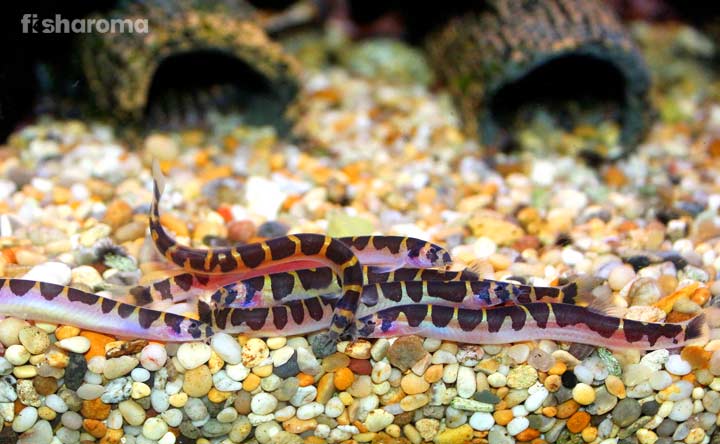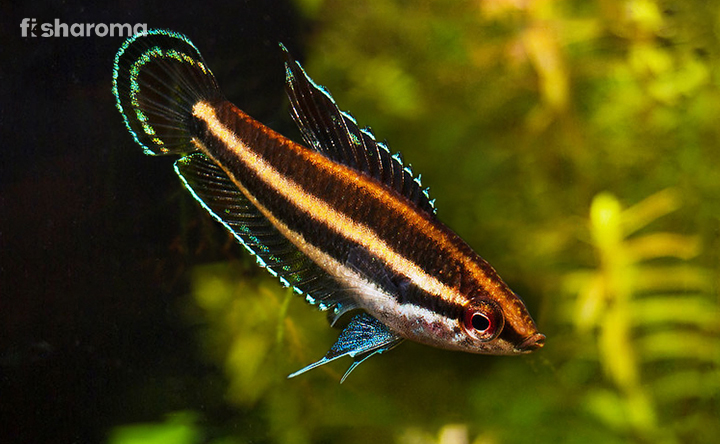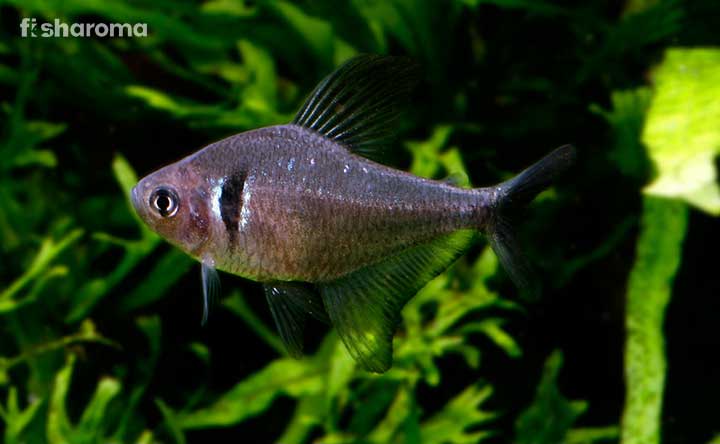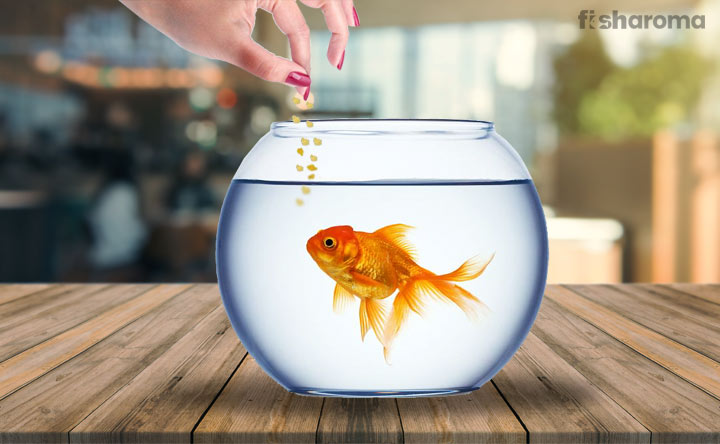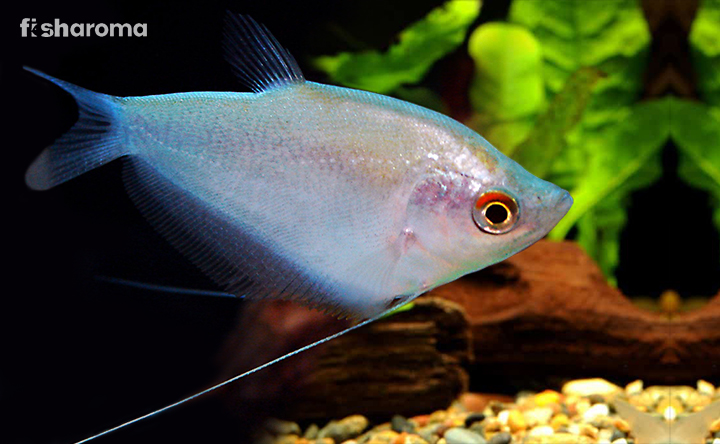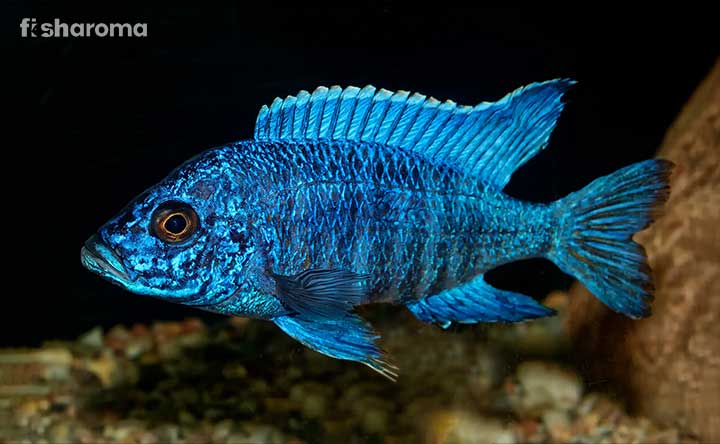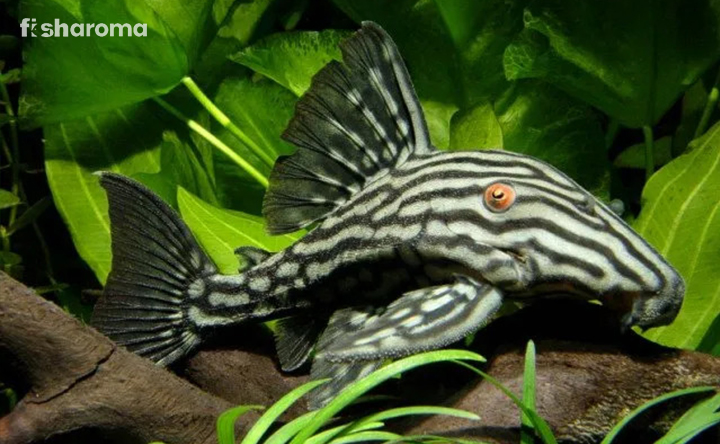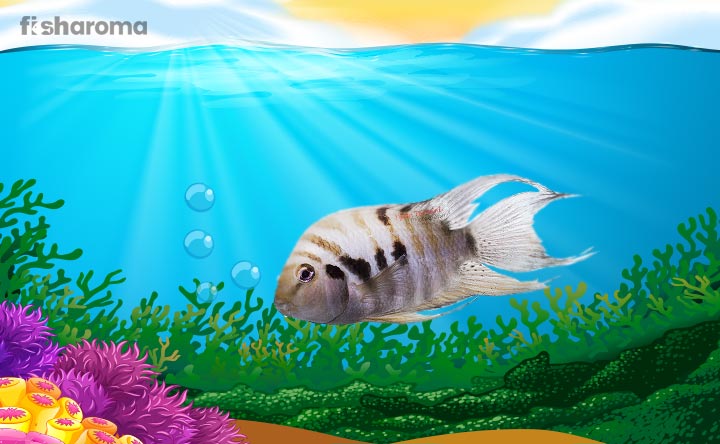Blood Parrot Cichlid- A Care Guide For Our Glamorous Buddy
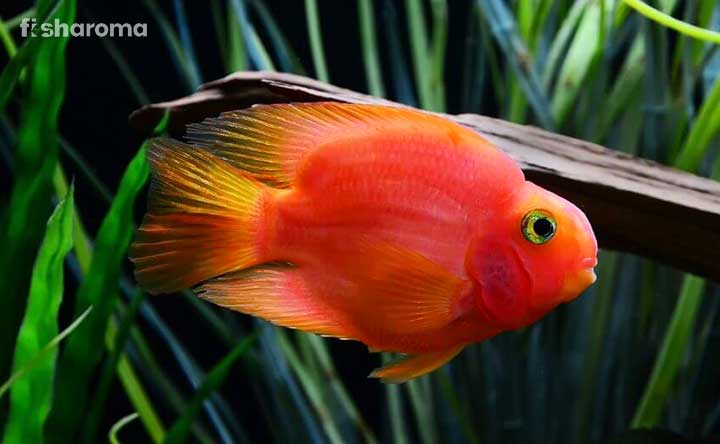
- Origin & Habitat of Blood Parrot Cichlid
- Appearance of Blood Parrot Cichlid
- Behaviour of Blood Parrot Cichlid
- Lifespan of Blood Parrot Cichlid
- Diet of Blood Parrot Cichlid
- Tank Requirements for Blood Parrot Cichlid
- Water Type for Blood Parrot Cichlid
- Compatibility of Blood Parrot Cichlid
- Suitable Tank mates for Blood Parrot Cichlid
- Breeding of Blood Parrot Cichlid
- Diseases of Blood Parrot Cichlid
- Summary
Blood Parrot Cichlid is an exquisite breed, known for its striking colour and beauty in the tank. They are known to be quite controversial, for their complicated breeding and intermediate care process. Not recommended for a beginner aquarist, these Cichlids are very similar to Central American Cichlid.
If you are planning to add these exquisite beings to your list, this article prepares you for it. Presenting you everything you need to know about this fish in our complete Blood Parrot Cichlid care guide. If you are a new practitioner in the hobby or an advanced aquarist, do read on!
Key Specifications
Before you move forward with the article, let us brief you with some key elements you must go through:
| Scientific Name | Amphilophus citrinellus x Paraneetroplus synspilus |
| Origin | Taiwan |
| Lifespan | About 15 years. |
| Colours/Patterns | Bright orange, red, yellow and grey. |
| Temperament | Partially aggressive. |
| Size | Up to 8 inches. |
| Diet | Omnivorous |
| Family | Cichlidae |
| Compatibility | Prefer a species only tank. |
| Tank size | 30 gallons |
| Care level | Intermediate |
| Water preference | Freshwater |
Overview
Scientifically known as Amphilophus citrinellus x Paraneetroplus synspilus, a Blood Parrot Cichlid is a glamorous fish. A pure radiant red, or an orange-ish colour, the glare of its tint, is where the serenity hides. An absolute treat to the eye, these Cichlids are a hybrid species with cousins who look identical. To have one of these is sure worth the expense, and the hard work it demands.
Origin and Habitat of Blood Parrot Cichlid
Blood Parrot Cichlids are a hybrid species of fish. There is not really much information on the parent specimens, off of which they have been artificially induced. This breed has stirred quite a controversy, for the presence of too many anatomical anomalies. Their process of breeding has been a talk of the town, nevertheless, the species look absolutely phenomenal. Factually, their breeding was done initially in Taiwan, and it is their known place of origin.
They are a huge fan of hiding spaces and prefer plenty of them. There is no specified natural habitat for them, as they were artificially induced. It is recommended to study the natural habitats of their parent species, as they are a result of hybridization. The temperate waters of Central America is ideal for emulation purpose. Proper recreation of their natural, or in this case a compatible habitat is always healthy. A species-only tank is a good choice, as aggressive fishes overwhelm them. They cannot compete for food in the tank.
Appearance of Blood Parrot Cichlid
It is a species of colour, with a profile ranging from radiant red to bright orange-ish mostly. It can safely be stated way high up, in the charts of the most vibrant fishes out there. Their exquisite tint-concentration, and the appeal of it is certainly fascinating. They have huge fins which look majestic, with a mouth resembling the beak of a bird along with their large eyes.
Size
An average adult fish is expected to grow about 8 inches, the jumbo versions can go as high as 10 inches. They require an average tank of 30 gallons with enough hiding spaces, as it is in their nature.
Colour
They have a really bright variant of orange, which is extremely attractive. The colours can vary between red, grey and yellow. Their majestic appeal and colour is very good for the aquarium. It leads to an immediate rise in aesthetic, especially with lack-lustre species it is a good balance. Since it is a hybrid fish, the usage of artificial dye is very common. It is detrimental for the fishes health, even reducing their lifespan, so never fall for over-exaggerated tint, and appreciate their natural beauty.
Behaviour of Blood Parrot Cichlid
The Blood Parrot Cichlid is a very friendly species, but the synergy is maximum between them. Thus, as per recommendation, they are preferably kept in a same-species tank for perfect compatibility. They like to hide, so the presence of enough hiding spots, like spacious hidden caves or passageways within the aquarium.
These private species have a very special, rather interesting feature of interacting with their owners. They are mostly easy-going and, as a result of their good bond between themselves, they tend to stick up against other breeds. Their mouth shape is odd, and it prevents them from inflicting any serious damage to a bigger fish, or a fish of similar size.
Lifespan of Blood Parrot Cichlid
These species live up to 15 years, which is quite long. They are expensive, but is absolutely worth the price. This type of Cichlids could be complex to care for, as they are only recommended for aquarists with intermediate-level experience. To keep them healthy and their lifespan unaffected, environment and water parameters must be kept under check. That way they can reach their potential in entirety. It is also recommended to dislike the idea of Blood Parrot Cichlid fishes with exaggerated colours, enhanced with artificial chemical dyes, as it messes with the life expectancy of the fish.
Diet of Blood Parrot Cichlid
The Blood Parrot Cichlid follows an omnivorous diet. It is fortunately not very complex to feed them. They accept most commercial fish food, preferably dry food or pellets. We recommend you to feed them sinking pellets, as they have issues in consuming floating surface ones. Food items high in canthaxanthin and b-carotene, is good for the maintenance of their vibrancy in colour.
To make it easy for you, we have stated a few food items you would like to choose from, while you work on feeding them:
Some options for a high-protein boost (preferably fed 2-3 times a week):
- Brine shrimp
- Bloodworms
Some common food options:
- Sinking pellets
- Flakes
- Frozen fish-food
- Dried fish-food
Tank Requirements for Blood Parrot Cichlid
Here goes few requirements in the tank necessary to keep a Blood Parrot Cichlid:
Tank Lid
They are fast swimmers, and it is a default recommendation for them to have a proper tank lid. They do not prefer the surface as such, still their interactive nature, and fast movement should be kept under check with a proper lid. Other than that, tank lids in general provide protection, against tank-water pollution by preventing dust from outside getting mixed.
Tank Size
An average tank of about 30 gallons works just fine with them. They are not very big, but their hiding nature and fast-playful interaction techniques might call for the need of one. Even if it is a little bigger, we recommend you to play it safe. If there are multiples of these, it is recommended to have a tank of at least 50 gallons.
Substrate
A sand substrate, or a smooth layer of gravel is a fitting substrate for this species.
Filter
A powerful filter always benefits the fish. They do produce enormous amounts of waste, so, regular to alternate cleaning is always good. A filter with decent current-movement ability, alongside a heater, is a perfect fit.
Ornaments
Well hidden caves can provide good hiding spots. It is suggested for their need of hiding spots as it supports their nature. Otherwise good usage of plants or flowerpots is a good addition, as it enhances the look of the aquarium, giving it a ravishing look.
Lighting
Lighting should be fine, but a little sunlight does not hurt, it is beneficial to the healthy environment of the aquarium as a whole.
Presence of Flora
They like a good, thick cover of vegetation. It is good for them, shelter-wise. More vegetation contributes to higher oxygen levels and fishes benefit from that. Vegetation like Fern, Hornwort and similar types of nature fragments are recommended.
Cleaning Method
Cleaning the tank on alternate days is a good choice. To keep the substrate clean or replace it with fresh ones if necessary. Usage of a cotton cloth to clean the sides of the glass filter is important for the overall maintenance of sanity. Cleanliness is healthy, and it extends the breed’s lifespan to its potential expectancy.
Water Type for Blood Parrot Cichlid
Shifting focus from the above-stated criteria, let us have a quick look at the water parameters, that is necessary for the fish’s survival. The water situation in the tank determines the health, and sanity of the fish, besides the obvious factors.
The care routine of Blood Parrot Cichlid fishes is not everyone’s cup of tea, once everything boils down to specifics. To make it a little easier to meet them, we present you with a simplified version of what you basically need to be careful about. Especially before you get a couple of these in your aquarium, here’s a must-have list:
| Hardness | 6 to 18 dGH |
| Temperature | 24-26 Degrees Celsius |
| pH | 6.5-7.4 |
Hardness
A minimum general hardness of 6 dGH is necessary, and it can go as high as 18 dGH. They do not have a factual preference to model after, but this is a comfortable parameter.
Temperature
A temperature range of about 24-26 Degrees Celsius, has been recommended. They like their water warm, and may even require, a water heater for the same.
pH
A minimum pH of about 6.0 is important, max about 7-7.4. This certain profile feature, must be kept in check for the health-sake of the fish.
Compatibility of Blood Parrot Cichlid
They are peaceful and friendly beings, who are at their best in an exclusive species only tank. Aggression is not for them and, aggressive fishes make them uneasy. They are not meant to compete for food and, they prefer a peaceful community.
Suitable Tank mates for Blood Parrot Cichlid
They are mostly shy around incompatibility and, they lack strong enough defence mechanisms to snatch and eat. This variant of cichlid is mostly compatible with its own kind. They are friendly fishes with unique qualities, who, ideally belong to a peaceful community, as it matches their nature. Here are a few compatible breeds you can safely pair up with Blood Parrot Cichlid fishes:
- Angel fish
- Silver Dollars
- Bala Sharks
- Plecostomus
- Clown Loach
- Kuhli Loach
- Yoyo Loach
- Tiger Barbs
Breeding of Blood Parrot Cichlid
Finally, we are at the most controversial topic. As we know, the breeding system of these hybrid species has been the talk of the town for quite some time. Not much is known about their parent species other than the fact, it has probably been bred from the Gold Severum Cichlid and the Midas Cichlid.
This breed as a result of hybridism seems to have various anatomical deformities. Their out of the ordinary mouth shape is one of them, with the presence of a quite narrow opening, which makes feeding complicated.
Besides their own breeding origin, let us dive into how they breed. The females prefer a hard surface to lay eggs on. The males are not fertile, so, they usually guard the potential fry together. The eggs are mostly consumed by either of the parents, if the brood gets spoiled by catching some kind of fungus. To make a male mate requires some luck. In order to increase the odds, a gradual temperature rise and a clean environment is good.
Diseases of Blood Parrot Cichlid
Mostly, the Blood Parrot Cichlid fishes are hardy and, they have the ability to mostly look after themselves. But they are not invincible and, are very well prone to diseases, like every other fish.
A few of the common fish diseases seen in this particular variant are as follows:
- Swim Bladder Disease
- Bacterial infections
- Ich parasites
Treatment
There goes a few ways one can keep the fish health in check or rather, treat them:
- Raising the water temperature, as warmer temperature provides them with relief.
- Copper water treatments always help.
- Regular cleaning of the tank, that includes changing the water from time to time, cleaning the filter system and, getting rid of any unnecessary stores that might affect the fish health.
Summary
Blood Parrot Cichlid fish, they are ravishing beings of quality and vibrancy. Their rich colour composition is extremely attractive. They are of intermediate difficulty when it comes to the care level, but you can do it with some practice and study. Friendly, rather interesting qualities like greeting owners, or at least recognition of the feeding hand is adorable.
Their hybrid nature and breeding is a little controversial. Despite that, they are majestic beings of massive beauty and magnificence. It is a must purchase, as their head value is nothing compared to how long they live or, how interactive they are. Their compatibility is decently on the nicer side with most fishes, who belong to a peaceful community and they work perfectly in a species-exclusive tank. All in all, they are a fit purchase if you are an aquarist with some experience or a hobbyist with a clear understanding. These intelligent and appealing beings in our opinion, is just the right fit for you.
Similar Care Guides you may like:
- Flowerhorn Cichlid Care Guide: They have a distinct bulge on top of their heads and are known for the same.
- German Blue Ram Care Guide: Belonging from the Cichlidae family these vibrant Cichlids grow about 2-3 inches.
- Firemouth Cichlid Care Guide: Highly beginner-friendly fishes, just like our Blood Parrot Cichlid fish, these fishes make for a good addition to your tank.

